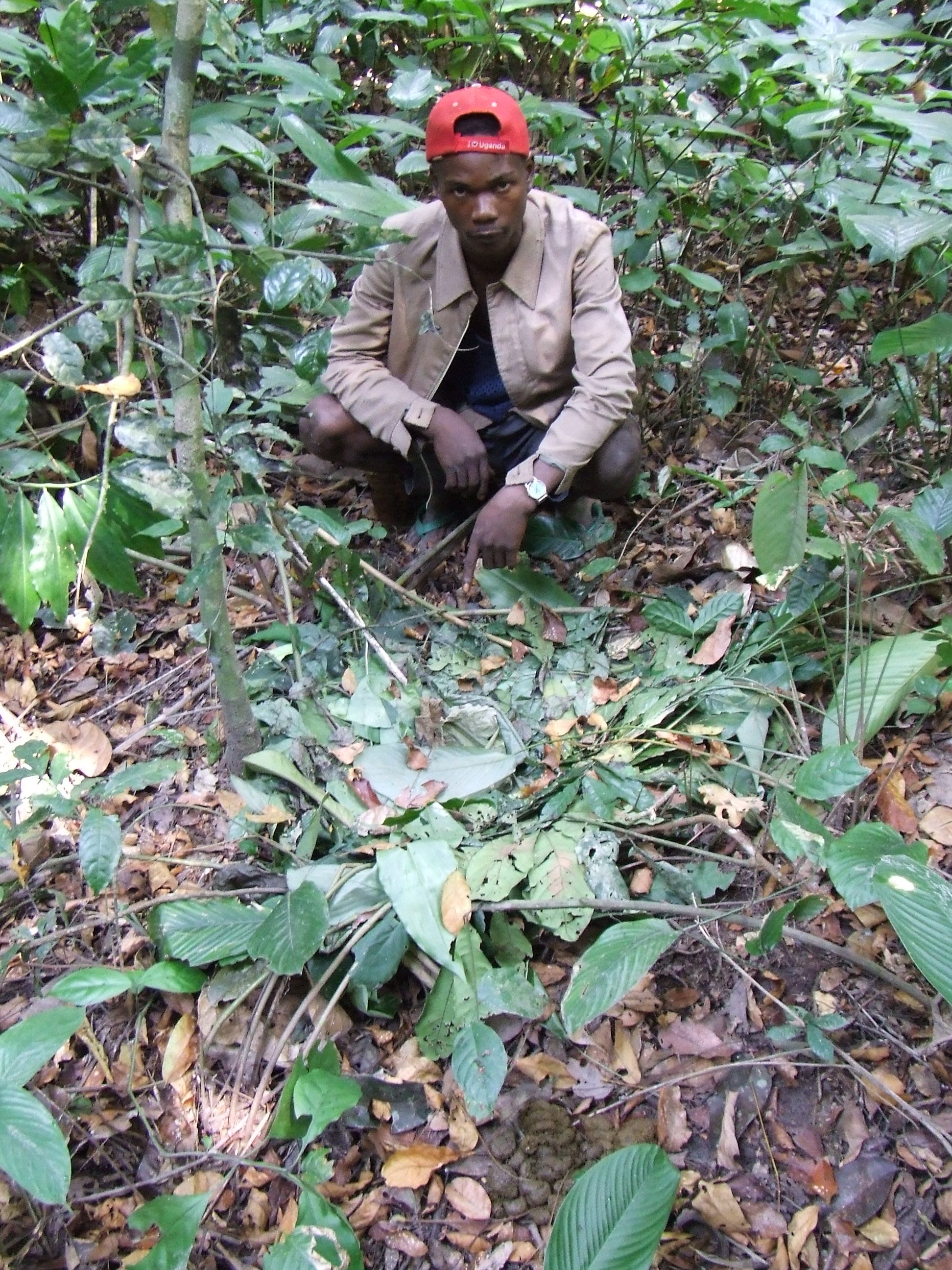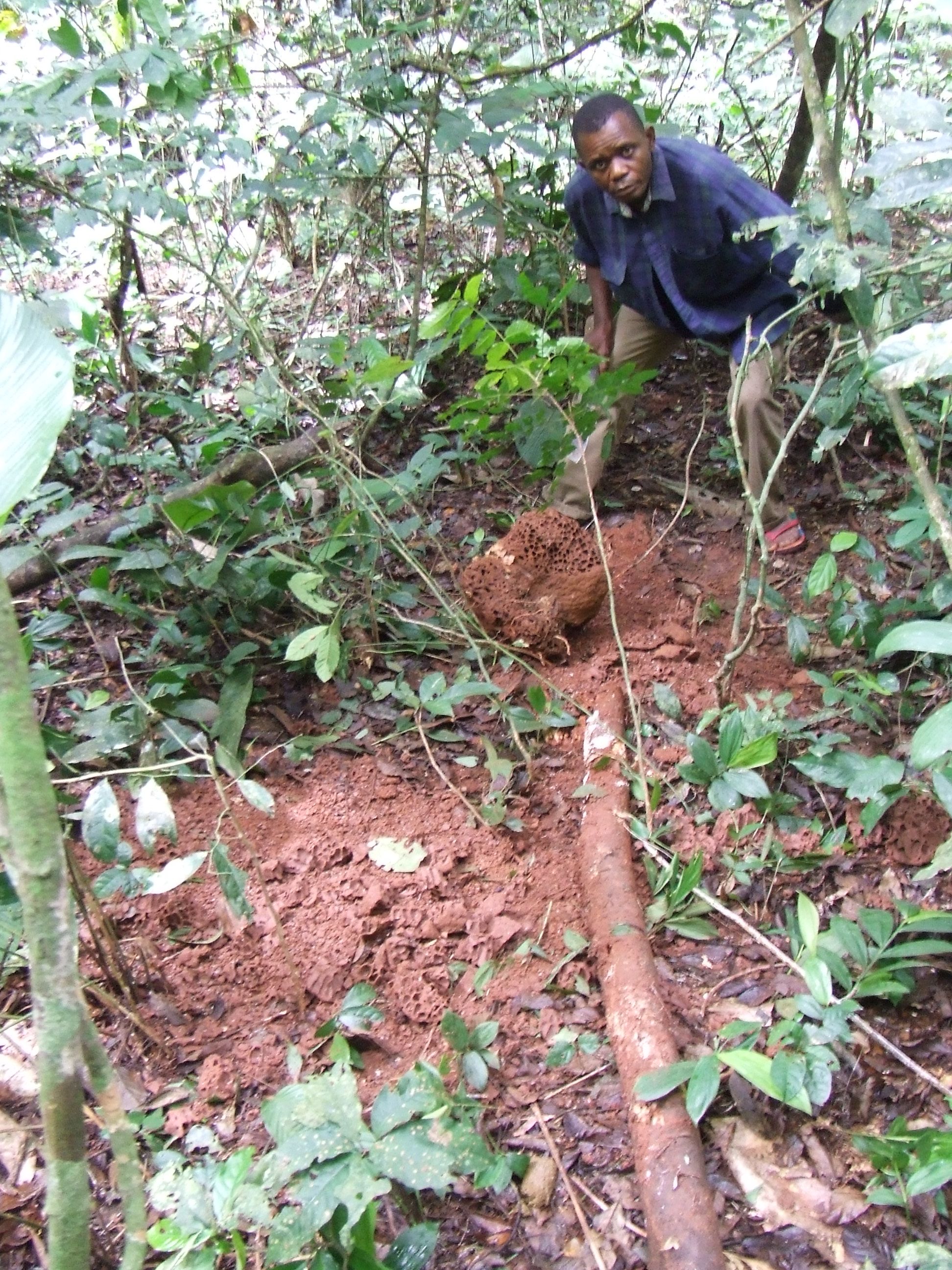Difference between revisions of "Bili–Uéré"
| Line 267: | Line 267: | ||
<div><ul> | <div><ul> | ||
| − | <li style="display: inline-block;"> [[File: GanguGroundNest.JPG |300px | | + | <li style="display: inline-block;"> [[File: GanguGroundNest.JPG |300px |frame| caption| Gangu ground nest with Likambo © Cleve Hicks/The Wasmoeth Wildlife Foundation 2007]] </li> |
| − | <li style="display: inline-block;"> [[File: PolycarpeTermiteSmashLiguga.JPG |300px | | + | <li style="display: inline-block;"> [[File: PolycarpeTermiteSmashLiguga.JPG |300px |frame| caption| Kisangola Polycarpe with termite pound site, Leguga Forest near the Uele River © Cleve Hicks 2008]] </li> |
</ul></div> | </ul></div> | ||
Revision as of 05:30, 14 November 2020
Central Africa > Democratic Republic of the Congo > Bili-Uéré
Summary
- Eastern chimpanzees (Pan troglodytes schweinfurthii) are present in Bili-Uéré.
- It has been estimated that 313-984 individuals occur in the site.
- The chimpanzee population trend is stable.
- The site has a total size of 60,000 km².
- Key threats to chimpanzees are hunting, mining, and deforestation due to agricultural expansion.
- Conservation activities implemented at the site include forest patrols and a community conservation project.
Site characteristics
The Bili-Uéré Domaine de Chasse is the largest protected area in DRC. Created in 1974 (République Démocratique du Congo Ministere des Travaux Publics et Infrastructures, 2007), it follows the border of the Central African Republic and covers a total area of 60,000 km² (Doumenge, 1990, cited from pers. comm. with Direction Générale IZCN, Kinshasa 1988). The domaine de chasse is made up of seven blocks, including the Mbomu Reserve. The region to the north of the Uele River is characterized by extensive areas of savanna and savanna woodland, mixed with islands of old-growth tropical moist forest. The savanna is interlaced with hundreds of small streams and rivers, many of which dry up in the dry season, and which harbor lush gallery forests. The savanna eco-type becomes progressively more predominant to the north towards the Mbomu River. The fauna is a mix of savanna species such as aardvark, warthogs, lions and bushbuck, together with forest species: forest buffalo, forest elephant, giant forest hog, land leopard. Nine species of non-human primate occur (Hicks 2010a).
Table 1. Basic site information for Bili-Uéré
| Area | 60,000 km² |
| Coordinates | 4.537 N, 25.332 W |
| Designation | Forest Reserve |
| Habitat types | Subtropical/tropical moist lowland forest, woodland, grassland, subtropical/tropical heavily degraded former forest |
IUCN habitat categories Site designations
Ape status
In the Domaine de Chasse, no significant difference in the encounter rates of chimpanzee nests was found between 2005 and 2012 (Hicks et al. 2014).
Table 2. Ape population estimates in Bili-Uéré
| Species | Year | Abundance estimate (95% CI) | Density estimate [ind./ km²] (95% CI) | Encounter rate (nests/km) | Area | Method | Source | Comments | A.P.E.S. database ID |
|---|---|---|---|---|---|---|---|---|---|
| Pan troglodytes schweinfurthii | 2005-2012 | 313-984 | 0.66-2.08 | 3.03 (2.01-4.58) | 473.1 km sq | Line transects (Distance) | Hicks et al. 2014 |
Threats
Table 3. Threats to apes in Bili-Uéré
| Category | Specific threats | Threat level | Quantified severity | Description | Year of threat |
|---|---|---|---|---|---|
| 1. Residential & commercial development | Absent | ||||
| 2. Agriculture & aquaculture | 2.1 Annual & perennial non-timber crops | Present, but threat severity is unknown | 25% of the site is affected (Hicks, C. pers. observation). | Slash and burn agriculture near roads and villages (Hicks et al. 2012). | 2004-2012 |
| 3. Energy production & mining | 3.2 Mining & quarrying | Low | 20% of the site is affected (Hicks, C. pers. observation). | Gold miners invaded the area in 2007, leading to the abandonment of a conservation project. Overall rates of mining are low compared to other nearby areas (Hicks et al. 2013). | 2007-2012 |
| 4. Transportation & service corridors | Absent | ||||
| 5. Biological resource use | 5.1 Hunting & collecting terrestrial animals | Low | 50% of the site is affected (Hicks, C. pers. observation) | Bushmeat hunting (Hicks et al. 2010b, Hicks et al. 2012). | 2004-2012 |
| 6. Human intrusion & disturbance | Absent | ||||
| 7. Natural system modifications | Absent | ||||
| 8. Invasive & other problematic species, genes, diseases | Unknown | ||||
| 9. Pollution | Absent | ||||
| 10. Geological Events | Absent | ||||
| 11. Climate change & severe weather | Unknown | ||||
| 12. Other options | Absent |
Conservation activities
Between 2002 and 2007, The Wasmoeth Wildlife Foundation ran a community conservation project at Bili (Hicks 2010a). Since 2012, AWF and ICCN have collaborated on patrolling the forest (Lushimba 2018).
Table 4. Conservation activities in Bili-Uéré
| Category | Specific activity | Description | Year of activity |
|---|---|---|---|
| 1. Residential & commercial development | Not reported | ||
| 2. Agriculture & aquaculture | 2.11. Farm more intensively and effectively in selected areas and spare more natural land | The Wasmoeth Wildlife Foundation bought local coffee in exchange for help protecting wildlife (Hicks 2010a). | 2002-2007 |
| 3. Energy production & mining | Not reported | ||
| 4. Transportation & service corridors | Not reported | ||
| 5. Biological resource use | 5.6. Conduct regular anti-poaching patrols | With the support of the African Wildlife Foundation, ICCN conduct anti-poaching patrols (Lushimba 2018). | Ongoing (2018) |
| 6. Human intrusion & disturbance | Not reported | ||
| 7. Natural system modifications | Not reported | ||
| 8. Invasive & other problematic species, genes, diseases | Not reported | ||
| 9. Pollution | Not reported | ||
| 10. Education & Awareness | Not reported | ||
| 11. Habitat Protection | Not reported | ||
| 12. Species Management | Not reported | ||
| 13. Livelihood; Economic & Other Incentives | Not reported |
Conservation activities list (Junker et al. 2017)
Challenges
Lawlessness, corruption and inaccessibility hinder conservation work. Fortunately human impact and population density remain low (Hicks et al. 2010).
Table 5. Challenges reported for Bili-Uéré
| Challenge | Source |
|---|---|
| Conflict on land tenure | Hicks et al. 2016 |
| Lack of law enforcement | Hicks et al. 2010 |
Research activities
Hicks and team conducted surveys to estimate chimpanzee population densities (Hicks et al. 2014). In addition they published papers on chimpanzee conservation in the area (Hicks et al. 2010), behaviors (Hicks et al. 2012 and 2013), material culture (Hicks et al. 2019a and 2020) and faunivory (Hicks et al. 2019b).
Documented behaviours
Table 6. Ape behaviors reported for Bili-Uéré
| Behavior | Source |
|---|---|
| Making ground nests | Hicks et al. 2019a |
| 5 kinds of tools for insects and honey | Hicks et al. 2019a |
| Termite mound pounding | Hicks et al. 2019a |
| Possible snail and tortoise pounding | Hicks et al. 2019a |
External links
It's a matter of taste: Chimpanzee cultural realms in Congo | Cleve Hicks | TEDxUniversityofWarsaw
On Assignment: Mystery Apes of the Congo NBC News
On Assignment: One More Thing - Mystery Apes of the Congo NBC News
Relevant datasets
References
Lushimba, A. (2018, July 5). Enhancing management and security in Bili-Uele. African Wildlife Foundation. https://www.awf.org/blog/enhancing-management-and-security-bili-uele.
Doumenge C. (1990). La Conservation des Ecosystèmes Forestieres du Zaïre. UICN, L’Alliance Mondiale pour la Nature, La Commission des Communautés Européenes. 242 pp.
Hicks, T. C. (2010a). A chimpanzee mega-culture. Exploring behavioral continuity in Pan troglodytes schweinfurthii across northern DR Congo. University of Amsterdam, Netherlands: PhD thesis.
Hicks, T. C., Darby, L., Hart, J., Swinkels, J., January, N., & Menken, S. (2010b). Trade in orphans and bushmeat threatens one of the Democratic Republic of the Congo’s most important populations of Eastern Chimpanzees (Pan troglodytes schweinfurthii). African Primates, 7(1), 1-18.
Hicks, T. C., Roessingh, P., & Menken, S. B. (2012). Reactions of Bili‐Uele Chimpanzees to Humans in Relation to Their Distance From Roads and Villages. American Journal of Primatology, 74(8), 721-733.
Hicks, T. C., Roessingh, P., & Menken, S. B. (2013). Impact of humans on long-distance communication behaviour of eastern chimpanzees (Pan troglodytes schweinfurthii) in the Northern Democratic Republic of the Congo. Folia primatologica, 84(3-5), 135-156.
Hicks, T.C., Tranquilli, S., Kuehl, H., Campbell, G., Swinkels, J., Darby, L., Boesch, C., Hart, J. and Menken, S.B., (2014). Absence of evidence is not evidence of absence: discovery of a large, continuous population of Pan troglodytes schweinfurthii in the Central Uele region of northern DRC. Biological conservation, 171, pp.107-113.
Hicks, T. C. (2016). A Leopard’s Breakfast Interrupted: Further Explorations of a Congolese Wilderness. In We Discover. Marc Guttman, Editor. Pronoun Books. 370 pp.
Hicks T. C., Kühl H. S., Boesch C., Dieguez P., Ayimisin A. E., Fernandez R. M., Zungawa D. B., Kambere M., Swinkels J., Menken S. B. J., Hart J., Mundry R. & Roessingh R. (2019a). Bili-Uéré: A chimpanzee behavioral realm in Northern DR Congo. Folia Primatologica. 90: 3-64
Hicks T. C., Menken S. B. J., Laudisoit A., Hart J. (2019b). Handling and consumption of vertebrate prey by chimpanzees (Pan troglodytes schweinfurthii) in Northern DR Congo. In Chimpanzees: Classification, evolution and behavior. Mary Lee Jensvold (ed.). Nova. Pp. 1-34.
Hicks, Thurston C., Hjalmar S. Kühl, Christophe Boesch, Steph BJ Menken, John Hart, Peter Roessingh, Corneille Ewango, and Roger Mundry (2020). The Relationship Between Tool Use and Prey Availability in Chimpanzees (Pan troglodytes schweinfurthii) of Northern Democratic Republic of Congo (advance online).International Journal of Primatology.
République Democratique du Congo, Province Orientale, District du Bas-Uélé, Territoire de Aketi: Rapport Annuel Territoire de Aketi, Exercice 2007. 28 février 2008. Census carried out from Aketi, by the Administrateur de Territoire Théophile Zungalani, Chef de Bureau.
Page completed by: Cleve Hicks Date: 13/11/2020


